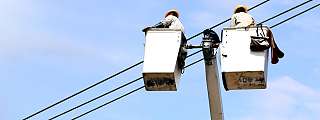Our fuel expenditure dropped by around 15%, reducing our overall carbon footprint while improving productivity.






About BinClean
About BinClean
Since launching in 2002 BinClean SA has grown into one of South Africa’s leading waste management companies, offering waste management solutions that result in vastly reduced carbon footprints, which positively impacts the environment. BinClean’s extensive network enables the company to find waste management solutions that fit customers’ requirements, and provides them with hassle-free waste management services.
The company’s core business centres around skip and bin hire – BinClean SA only rents out its own skips and bins and does not utilise any client-owned containers, skips or bins.
The Challenge
The Challenge
In the past, BinClean dispatchers would communicate with drivers via two-way radio. Drivers would be provided with a list of all their trips for the day and use a map book to find the various addresses.
If there was a spelling mistake on the order sheet or there were pages missing from the map book, precious time would be wasted. More importantly, the company’s ability to deliver an excellent level of service would be compromised.
The overtime bill was eating into profitability and every resource was stretched to the limit, limiting the rate at which the company could grow in Gauteng and elsewhere.
The Solution
The Solution
BinClean CEO Neil Yates admits that, prior to the introduction of the Webfleet system, he was doubtful about the ability of any system to address the company’s unique requirements and challenges.
In 2015 BinClean installed the Link 510 tracking device into all its vehicles – it has a total of 11 vehicles – as well as the Webfleet fleet management and vehicle tracking system across its dispatch centres linked to mobile terminals.
The system optimised the company’s logistics planning onto a single integrated software system, resulting in an estimated 20% increase in production.
Thanks to the improvements in production efficiency, we were amazed to discover that we had one more vehicle than we actually needed,
Yates says. This might not sound like much, but it’s reduced our overtime bill by 50% and we have been able to do 20% more work in a day, consuming half the overtime costs with one less vehicle.
Also, our fuel expenditure dropped by around 15%, reducing our overall carbon footprint while improving productivity. As we were able to complete more work each day at much lower cost, we were able to grow the business faster and serve more clients at a much higher level of excellence and precision
, he says.
With the help of the Webfleet system, operator errors were significantly reduced as all orders would be sent remotely to each unit directly from the dispatch office. The system indicates if there are any problems with the addresses (such as spelling errors or name changes) and navigates the vehicle to the exact delivery location via the most efficient route.
The Webfleet system helps owners to optimise their fleets, provide real-time information about the location of vehicles and lets managers communicate directly with drivers.
Whether used in a single car or a national fleet of hundreds of vehicles, these systems offer improvements in driver behaviour, substantial fuel savings, and enable seamless connection to an ecosystem of third-party solutions, such as office applications, Bluetooth® wireless technology devices*, temperature sensors, tyre pressure monitors, barcode scanners, printers and various display terminals.
Binclean SA found the perfect fleet management solution with these components1:
LINK
PRO
Build the right fleet management solution for you in seconds
Want to boost your business?
Receive the latest industry news, product announcements and fleet management updates.






Your consent is required
In this section, external content is being embedded from .
To display the content, your consent is required for the following cookie categories:
- Targeted Advertising
- Analytics & Personalization
- Essential
For further details, please refer to our privacy policy. If you are interested in how ###vendor_name### processes your data, please visit their privacy policy.








